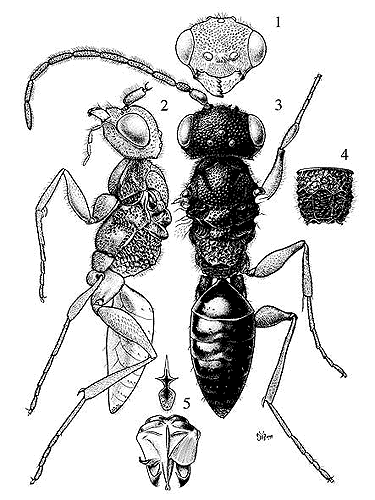New taxonomic status for Anteon faciale and A. pseudohilare (Hymenoptera: Dryinidae)
J.T. Burn & J. de Rond.
BURN, J. T. & J. DE ROND, 1999. NEW TAXONOMIC STATUS FOR ANTEON FACIALE AND A. PSEUDOHILARE (HYMENOPTERA: DRYINIDAE). - ENT. BER., AMST. 59 (1): 10-12.
Abstract : The status of Anteon faciale (Thomson), previously considered a junior synonym of A.ephippiger (Dalman), is restored and the male is described. Anteon pseudohilare Burn was compared with the holotype of A. faciale, and found to be identical.
J. T. Burn, 1 Sycamore Avenue, Armthorpe, Doncaster, South Yorkshire, DN3 3HQ England.
J. de Rond, Beukenhof 96, 8212 EB Lelystad, The Netherlands.
Introduction
The description of Anteon pseudohilare Burn, 1990 was based on a single female, found in a museum collection. After collecting several specimens in their natural habitat, the author was able to send some material to fellow hymenopterologists. When the second author received one of these females, he recognised an older species in it. While doing some research on the synonyms of Anteon ephippiger (Dalman, 1818), de Rond had come across the description of Anteon faciale (Thomson, 1860), which in no way appeared to agree with the type of A. ephippiger. Examination of the holotype of A. faciale, the only specimen upon which the species was based, finally proved the true identity of the British females: A. pseudohilare is indeed a junior synonym of A. faciale.
Anteon faciale (Thomson, 1860), stat. nov.
Type material
Holotype: F, Sweden, labelled with five minute printed cards; "Bhn" [= Boheman (leg.)] "Gl." [=Gotland], "Sc.", "Thoms." , "Type." No additional information on type locality or date in Thomson (1860).
Allotype: M , England, Hightown (Lancashire), 3.vii.1996, J.T. Burn.
Paratypes (labelled Anteon pseudohilare): 1F, England, Freshfield (Lancashire),1.vii.1953, S. Shaw; 1F, Hightown, 30.vi.1996, J.T. Burn; 2 F, Hightown, 1.vii.1996, J.T. Burn; 5F , Hightown, 3.vii.1996, J.T. Burn; 1F, England, Raven Meols Hills (Lancashire), 1.vii.1996, J.T. Burn. The allotype will be deposited at the British Museum (Natural History), London, UK.
Description of the male (figs 1-5)
Fully winged; Length approximately 2.5 mm; Black, antennae brown, slightly paler ventrally, more noticeably so on the scape.

Figs 1-5. Anteon faciale Thomson, habitus male (det. J.T. Burn and J. de Rond); 1, frontal aspect of the head; 2, lateral aspect of the body; 3, dorsal aspect of the body; 4, posterior aspect of the propodeum; 5, dorsal aspect of last sternite and genital apparatus (relative enlargement 1.6x).
Discussion
For the construction of determination keys many of the older authors have relied completely on details that are now known to be variable. Olmi (1984, 1994) therefore characterised most older descriptions as insufficient or unreliable, but gave no additional information on types of synonymized species. Trusting completely on his expertise it was virtually impossible to suspect the true identity of A. faciale. Why Anteon faciale was synonymised with A. ephippiger, while both species obviously have little in common, can be explained by a stong emphasis on colour. Some varieties of the latter species, for instance var. collare (Dalman), are not completely yellow, but black with reddish spots on the head and pronotum. The dark frons and yellow clypeus of A. faciale however, are quite the opposite of the reddish frons and black clypeus of A. ephippiger var. collare.
All the Lancashire sites are characterized by coastal sand dune vegetation, and all the specimens were obtained by searching on all fours amongst Marram grass (Ammophila arenaria (L.) Link). The Hightown specimens were from a small area on the fore-dunes, where there was relatively little, or no undergrowth amongst the Marram. The Raven Meols Hills specimen was taken much further inland on the lower slopes of a blow-out dune. The habitat of the Swedish record is not known.
Acknowledgements
With special thanks to Mr. Lars-Åke Janzon, at the Swedish Museum of Natural History, Stockholm, who was very helpful in sending us Thomson's type on loan and a copy of the original description.
References.
Burn, J.T., 1990. Two species of Anteon (Hym., Dryinidae) new to Britain, one new to science. - Entomologist's mon. Mag., 126: 185-186.
Olmi, M., 1984. A revision of the Dryinidae (Hymenoptera, Chrysidoidea).- Mem. Am. ent. Inst. 37, Part 1: i-xii, 1-946.
Olmi, M., 1994. The Dryinidae and Embolemidae (Hymenoptera: Chrysidoidea). of Fennoscandia and Denmark. - Fauna ent. scand. 30: 1-100.
Thomson, C.G., 1860. Sveriges Proctotruper. - Öfvers. K. Vetensk. Akad. Förh. 17: 169-181.